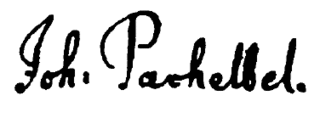
Organ tablature is a form of musical notation used by the north German Baroque organ school, although there are also forms of organ tablature from other countries such as Italy, Spain, Poland, and England. Portions of Johann Sebastian Bach's Orgelbüchlein are written in tablature, as are a great deal of the surviving manuscripts of the organ works of Dieterich Buxtehude and other north German organ composers of the Baroque era.

Music notation or musical notation is any system used to visually represent aurally perceived music played with instruments or sung by the human voice through the use of written, printed, or otherwise-produced symbols.

Germany, officially the Federal Republic of Germany, is a country in Central and Western Europe, lying between the Baltic and North Seas to the north, and the Alps, Lake Constance and the High Rhine to the south. It borders Denmark to the north, Poland and the Czech Republic to the east, Austria and Switzerland to the south, France to the southwest, and Luxembourg, Belgium and the Netherlands to the west.

The Baroque is a highly ornate and often extravagant style of architecture, music, dance, painting, sculpture and other arts that flourished in Europe from the early 17th until the mid-18th century. It followed the Renaissance style and preceded the Rococo and Neoclassical styles. It was encouraged by the Catholic Church as a means to counter the simplicity and austerity of Protestant architecture, art and music, though Lutheran Baroque art developed in parts of Europe as well. The Baroque style used contrast, movement, exuberant detail, deep colour, grandeur and surprise to achieve a sense of awe. The style began at the start of the 17th century in Rome, then spread rapidly to France, northern Italy, Spain and Portugal, then to Austria and southern Germany. By the 1730s, it had evolved into an even more flamboyant style, called rocaille or Rococo, which appeared in France and central Europe until the mid to late 18th century.
The first extant example of keyboard tablature, which was almost certainly for organ, was in the Robertsbridge Codex , from about 1360. Although it is English, it is closely related to the later German tablatures. An early and perhaps seminal example of these organ tablatures is found in the Buxheimer Orgelbuch (Buxheim Organ Book), compiled in Münich in the 1460s. It reflects the work of Conrad Paumann, a blind organist, lutenist, and composer. [1] The biggest organ tablature, as well as one of the oldest in the world, is Organ Tablature by Jan of Lublin (1537-48), one of ca. 20 Polish organ tablatures created from 1520 to 1700. An emblematic organ tablature of the early baroque era is the Linzer Orgeltabulatur, compiled between 1611 and 1613 and containing 108 pieces of mostly non-liturgical character.

The Robertsbridge Codex (1360) is a music manuscript of the 14th century. It contains the earliest surviving music written specifically for keyboard.
The Buxheim Organ Book is a manuscript created around 1460/1470 with 256 original compositions and arrangements for keyboard instruments for the Buxheim Charterhouse in Germany, in today's district of Unterallgäu. Most of the composers are anonymous, but some are also known composers of the time.
Jan z Lublina, or Joannis de Lublin, was a Polish composer and organist who lived in the first half of the 16th century. Not much is known about his life - he was a member of the Order of Canons Regular of the Lateran, circa 1540 he was possibly the organist at the convent in Kraśnik, near Lublin. Perhaps he is identical to one of the two Jans, the first of which received his master's degree in artibus et philosophia in 1499, and the second his baccalariatus in artibus in 1508 in the Kazimierz Academy in Krakow. From 1537 to 1548, he created the famous organ tablature, whose title is Tabulatura Ioannis de Lyublyn Canonic[orum] Reg[u]lariu[m] de Crasnyk. This is the largest organ tablature in the world and one of the earliest. It contains several compositions by Nicolaus Cracoviensis, as well as numerous intabulations of works written by Josquin, Heinrich Finck, Janequin, Ludwig Senfl, Claudin de Sermisy, Philippe Verdelot, Johann Walter, etc.
The feature of organ tablature that distinguishes it from modern musical notation is the absence of staves, noteheads, and key signatures. Pitches are denoted by letter names written in script, durations by flags (much like modern notation), although in early notations durations were shown using mensural indications, [1] and octave displacement by octave lines drawn above a letter. There was some variation in the notation of accidentals, but sometimes sharps were specified by the addition of a loop to the end of the letter. B natural and B flat were represented by h and b respectively. [2] Naturals are not indicated, as accidentals do not carry through the entire measure as in modern notation. Key signatures are not specified; they are implied by the indicated sharps. In Renaissance works the uppermost melodic line is given in normal mensural notation on a staff, and the tablature given below each note. [1]

Mensural notation is the musical notation system used for European vocal polyphonic music from the later part of the 13th century until about 1600. The term "mensural" refers to the ability of this system to describe precisely measured rhythmic durations in terms of numerical proportions between note values. Its modern name is inspired by the terminology of medieval theorists, who used terms like musica mensurata or cantus mensurabilis to refer to the rhythmically defined polyphonic music of their age, as opposed to musica plana or musica choralis, i.e., Gregorian plainchant. Mensural notation was employed principally for compositions in the tradition of vocal polyphony, whereas plainchant retained its own, older system of neume notation throughout the period. Besides these, some purely instrumental music could be written in various forms of instrument-specific tablature notation.
Since the end of the Baroque era, organ tablature has not been used to an appreciable extent. Repertoire originally written in tablature has been translated into modern notation. However, this translation carries a risk of error. In German script an A and an E can become confused, as can an F and a G. Likewise, an octave line over a series of notes can begin or end ambiguously. Different solutions are given by different editors, and this is one manifestation of the improvisatory tradition of organ performance of the period.













